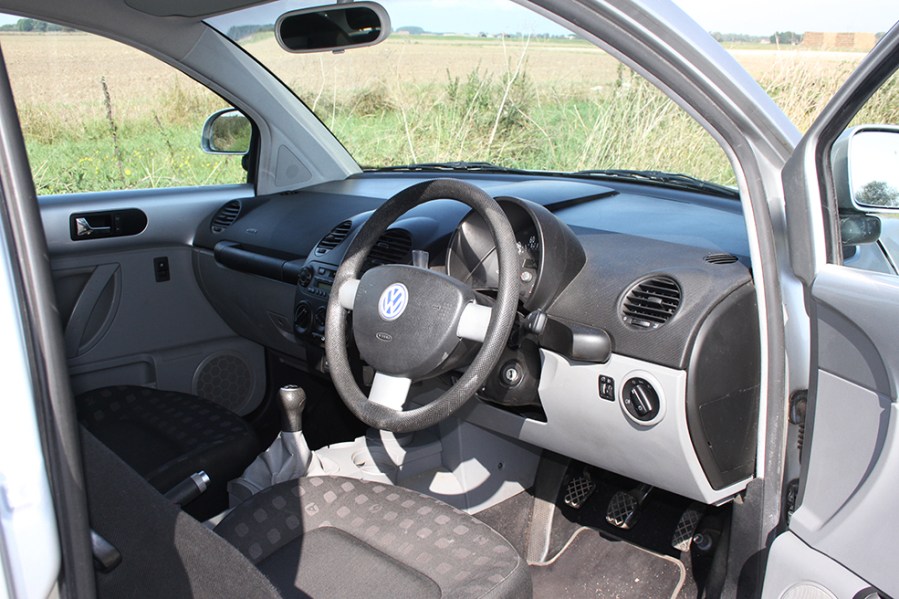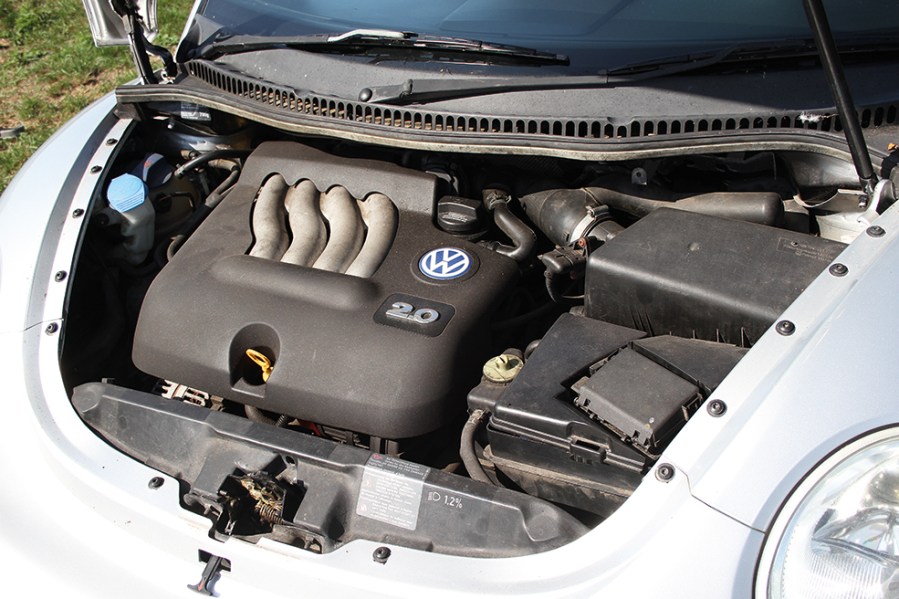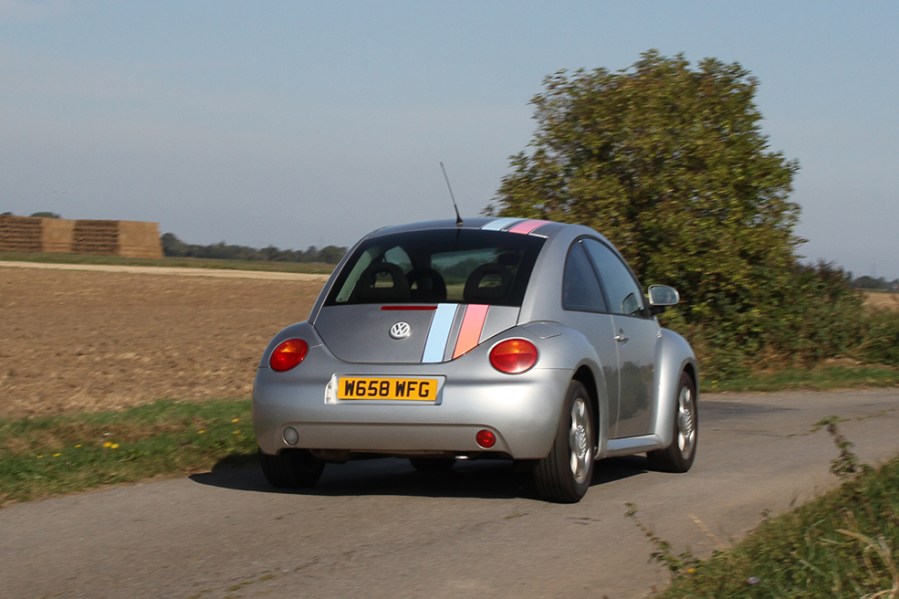A product of the retro movement of the late 1990s, the New Beetle has become a modern classic in its own right
Images: Simon Goldsworthy
The original Volkswagen Beetle was still being produced in Mexico (and would continue until July 2003) when a concept car created on a Polo platform and designed in the USA at VW’s California studio was exhibited at the North American International Auto Show in 1994.
Named Concept One, it took it styling cues from the original Beetle, and was perfectly timed to ride a swelling wave of nostalgia into production in 1997. By this time it was based on the bigger Golf platform, and it went down a storm. There was a facelift in 2005 that brought sharper creases to the styling, and a new New Beetle from 2011 that carried production through to 2019 before the plug was finally pulled.
Volkswagen did a good job of invoking the style and the spirit of the original Beetle while creating a totally modern car. VW incorporated features beyond the bulbous shape to reinforce the new car’s heritage, such as rear lamps that echo the ‘elephant feet’ lights of the original Beetle from 1973, sloping headlights and vestigial running boards. There is even a tiny plastic vase on the dash, acrylic rather than porcelain but a very tongue-in-cheek nod towards the bud vases that were popular accessories on the original Beetle from the 1950s onwards.
In true classic Beetle fashion the wheels really are planted right at the corners. Climb behind the wheel and that wheel-at-each-corner stance means that the pedals can be placed dead ahead and not offset at all. The seats are firm but comfortable, with enough shaping to the seat base to stop you sliding about.
The view out of the front is dominated by the dash, which is just so incredibly long. You can just about see the trailing edge of the bonnet ahead of that, but even if you lean forwards in your seat you can’t see much of the metalwork beyond that. You’re relying on guesswork as to where the front corners are; you’ve got no markers of any sort. I guess that’s one reason why so many Beetles have scrapes and dings on their extremities. The rest of the view out the front is fine with a very tall screen giving a feeling of space that I hadn’t expected to feel, especially given the size of the A-pillars.

The rear-view mirrors (interior and on the doors) are small, but very high up so they offer a decent view of the road behind. The headrests in the back have holes in the middle so they don’t limit your rearward vision too much, plus a decent space down the middle because this is strictly a four-seater. Sideways vision is excellent, although the waistline is high so you do feel as though you are sitting well down inside the car, rather than up on it as you do in something like an MGF for example.
The dashboard layout is fairly simple. Volkswagen drew elements from the original air-cooled Beetle in creating that simplicity, a fact emphasised by the use of a single round dial ahead of the driver. There’s a digital milometer in the speedo, accompanied by a fuel gauge to the left and a rev counter to the right. The rev counter is not much bigger than the fuel gauge and reasonably pointless.
I’d much rather have had a temperature gauge there because like many modern cars, this one has a coolant light that comes on until the engine gets up to temperature, then goes out. It is blue during this warming up stage, so presumably it comes back on red if temperatures are getting out of hand. I miss temperature gauges on cars, they are so much more useful for keeping an eye on any changes before they develop into problems, whereas when a warning light comes on, it is usually too late.
There are useful storage spaces around the Beetle as you would expect on a modern car, including net pockets in each door, a proper glove box, cup holders ahead of the gearstick and even a sun glasses tray up above the rear-view mirror. Talking of ‘up above the rear-view mirror,’ there really is a lot of ‘up above’ on the Beetle, more head room than I imagine any car has offered since the 1930s.
The heater controls are nice and simple, though sadly a radio-cassette rather than a CD player on this car. There is a folding arm rest between the two front seats, but its design is flawed because when it is down it is too high and too long so that if you rest your elbow on it, then your hand is bent awkwardly to reach the gear stick.
Leave the arm rest folded out of the way and the gearstick has a nice action. There are five forward speeds of course with a nicely weight spring-loading keeping the stick at rest in the central plane. On this car fifth can sometimes baulk a little, but I rather suspect that is a feature of the linkage on this example rather than of the model as a whole.

On the road
Dynamically, there is no doubt that the New Beetle is a very comfortable and very capable car. I have been driving it along some appalling minor Fenland roads that are slipping into the drainage ditches, and it takes everything in its stride. This one has a 2.0-litre engine, so there is ample power in what is ultimately a Golf in drag.
Unhurried driving takes you up to 15mph in first, 30mph in second, 40mph in third, 50mph in fourth… all of these keep the revs below 3000rpm and the red line is at 6500rpm, so obviously at these speeds you are only using a fraction of the available power and it is all very relaxed. You can add another 20mph to each of those change-up points without the revs getting silly, and even if you leave it in third until hitting 60mph you’ll still not have reached the red line, so it is a very flexible engine.
With a more sensible head on, driving through town at 30mph in fourth is easy enough and it will pick up without lugging when you put your foot down, but the car feels happier in third at around 2200rpm and has instant poke to offer when you reach a derestricted road. There is no obvious power band that hits you as the rev counter rises up the gauge. I take it up to 5000rpm and there is no change in character or push in the small of your back, it just keeps on pulling in a very linear fashion as the scenery starts to blur.
Ultimately, the New Beetle is an unusual car in that it is one of the few vehicles I have driven which feels as though it would benefit form a sixth gear. I know that in classic terms that is getting greedy as most classic owners would be grateful for a fifth gear, sometimes even a fourth one, but this does feel a little buzzy when cruising. I’m not sure why because it is not over-revving and it is not a noisy engine, so perhaps that just takes more time before you adapt and tune in to the car. Certainly it will sit quite happily at 70mph all day, it is just that I find myself reaching for the next gear around 60-65mph in fifth.
The steering is power-assisted, and this one feels in excellent shape because there is no free play at all. That doesn’t make the New Beetle nervous or prone to darting about because the steering is well damped, and we are running on fresh, good quality Kumho tyres so there is no squirming from them.
The New Beetle’s brakes are every bit as good as you would expect from a car of this class and age; well servo’d and offering plenty of feel if you are braking gently, followed by a fairly quick transition to more aggressive braking if you press harder that could potentially catch out the unwary.

Volkswgen New Beetle: our verdict
Nostalgia is a tricky line to tread, but I think Volkswagen has done well on the Beetle with enough nods to the past to make the point without overstepping the mark and becoming too kitschy. As a result, you could argue that the New Beetle offers the best of both worlds – styling that is nostalgic and fun, but running gear that is bang up to date – there’s fuel injection of course so cold starts are instantaneous and the engine shows a total lack of temperament as it warms up, the car runs happily on the cheaper E10 fuel available today (I did check with Volkswagen to make sure), a powerful heater is a given and so on.
Nostalgia does tend to sit uncomfortably alongside the notion of practicality, because if you were going for total practicality then you’d design a box like Volvo or Lada did. So thanks to the two-door configuration it does take a little gymnastics for an adult to thread their way into the back of the Beetle, even if the front seats both fold and slide.
The boot space is compromised too, though not as badly as I had expected from the curvaceous body – I’d describe it as perfectly adequate rather than cavernous. You can fold the rear seat forwards easily enough if you do want to make more room for luggage, though then of course it is no longer hidden from view.
But let’s be honest, this is not designed as a practical load-lugger, it is a fun car with retro styling cues. When viewed in that light, it is remarkable just how practical it is as a daily driver and for most regular domestic duties. The fact that it does all this while still making you smile every time you look at it is just a bonus.




















